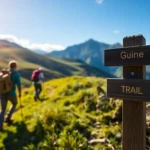Understanding Guided Hikes: What Sets Them Apart
Definition and Key Features of a Guided Hike
A guided hike is an organized outdoor adventure where participants are led by a knowledgeable guide through scenic trails or challenging terrains. Unlike independent hikes, guided hikes involve a professional who ensures safety, provides trail information, and enriches the experience with local insights. The key features of a guided hike include expert leadership, planned routes tailored to skill levels, logistical support, and often, additional amenities such as transportation, meals, or cultural experiences. In regions like Lombok, guided hikes often emphasize cultural immersion, environmental stewardship, and personalized attention, ensuring hikers gain a deeper understanding of the area while enjoying a safer and more comfortable journey.
For those exploring the concept of a guided hike in Lombok, it signifies more than just walking through picturesque landscapes; it’s about holistic travel experiences curated by local experts familiar with the terrain, climate, and cultural nuances.
Benefits of Joining a Guided Hike in Lombok
Participating in a guided hike in Lombok offers numerous advantages, especially for travelers seeking adventure combined with cultural enrichment and safety. Some of the primary benefits include:
- Expert Navigation: Guides are familiar with the trails and can navigate complex terrain efficiently, reducing the risk of getting lost or facing unexpected obstacles.
- Enhanced Safety: Guides are trained to handle emergencies, provide first aid, and communicate effectively with local rescue teams if necessary.
- Cultural Insights: Knowledgeable guides share local stories, traditions, and histories, transforming a physical hike into an educational experience.
- Environmental Conservation: Responsible guiding promotes sustainable practices, reduces environmental impact, and educates hikers on protecting natural resources.
- Customized Experience: Guides tailor routes and pacing to match the group’s fitness level, preferences, and interests, whether focusing on wildlife, photography, or cultural sites.
- Logistical Convenience: Guided hikes often include transportation, permits, meals, and equipment, simplifying planning and logistics for travelers.
In the vibrant landscapes of Lombok, such benefits are crucial for making the most of your adventure, whether you aim to conquer Mount Rinjani or explore hidden waterfalls and rural villages.
Types of Guided Hikes Available
Lombok offers a diverse array of guided hiking experiences tailored to different interests and skill levels:
- Mount Rinjani Trekking Tours: Multi-day adventures exploring Indonesia’s second-highest volcano, featuring crater lakes, hot springs, and panoramic vistas. These hikes often include acclimatization days, camping in the mountains, and expert guides to navigate volcanic terrain.
- Waterfall and Jungle Trails: Shorter guided hikes leading to waterfalls like Tiu Kelep and waterfalls hidden within lush rainforests. These are suitable for families and casual hikers wanting an immersive nature experience.
- Cultural Village Walks: Guided tours through traditional Sasak villages, offering insights into local crafts, architecture, and customs, often combined with scenic rice terraces or terraced hillsides.
- Coastal and Cliffside Trails: Guided hikes along the coastlines or mountain ridges, providing spectacular sea views, opportunities for snorkeling, and photography.
- Specialized Themed Hikes: Birdwatching tours, sunrise hikes, or photography excursions led by guides with expertise in specific interests.
Planning Your Perfect Guided Hike in Lombok
Choosing the Right Trail and Difficulty Level
The first step in planning your guided hike is selecting a trail that aligns with your fitness level, interests, and desired experience. Lombok’s hiking options range from leisurely village walks to strenuous multi-day treks. To make an informed choice:
- Assess Your Fitness: Be honest about your stamina, experience, and health conditions. For beginners or casual hikers, shorter, flatter trails such as rural village walks or waterfall excursions are ideal.
- Define Your Goals: Do you want scenic mountain views, wildlife encounters, cultural immersion, or an adrenaline rush? Clarify your priorities to narrow down options.
- Research Trail Difficulty: Trails are categorized from easy to very difficult, considering factors like altitude, terrain ruggedness, and length. For example, Mount Rinjani’s summit climb is challenging and requires preparation, while a mere few hours on Bukit Pergasingan is accessible for most.
Consulting local guides or tour operators can help you choose a trail that provides the right balance of challenge and enjoyment, ensuring a rewarding experience without overexertion.
What to Expect During a Guided Hike
Understanding what occurs during your guided adventure enhances your confidence and prepares you mentally and physically. Typical elements include:
- Pre-Hike Briefing: The guide introduces the route, safety protocols, expected challenges, and cultural or environmental highlights.
- Support and Navigation: Guides lead the group, share insights about flora, fauna, and local history, and ensure the trail is followed correctly.
- Rest and Meal Breaks: Scheduled breaks often include local snacks or meals, providing nourishment and opportunities to relax and socialize.
- Photographic Opportunities: Guides may suggest scenic spots for photos, viewpoints, or cultural sites.
- Environmental Engagement: Emphasis on Leave No Trace principles ensures minimal impact on the environment, with guides educating hikers on sustainability.
Expect a blend of physical activity, cultural storytelling, and nature immersion, all tailored to maximize enjoyment and learning.
Essential Preparation and Packing Tips
Proper planning ensures your guided hike in Lombok is safe and memorable. Consider the following:
- Appropriate Clothing: Layered clothing suited to the climate, moisture-wicking fabrics, and a rain jacket. For high-altitude treks, thermal wear and good hiking boots are vital.
- Footwear: Invest in quality hiking shoes with grip and ankle support to handle diverse terrains.
- Sun Protection: Sunscreen, sunglasses, hats, and UV-protective clothing are essential, especially during exposed or high-altitude sections.
- Hydration and Nutrition: Carry sufficient water, hydration tablets if necessary, energy bars, and fruits.
- Navigation and Safety Gear: Maps, GPS devices, whistle, first aid kit, and personal identification.
- Additional Items: Insect repellent, camera, spare batteries, and a lightweight towel or wipes.
Always follow the guidance of your tour operator regarding packing lists and dress codes, and prepare for variable weather conditions.
Top Guided Hike Spots in Lombok
Mount Rinjani Trekking Tours
Mount Rinjani is the crown jewel of Lombok’s hiking destinations. As Indonesia’s second highest volcano, it offers challenging multi-day treks that reward climbers with spectacular crater lakes, volcanic landscapes, and panoramic views. Guided tours typically span 2-4 days, including acclimatization and acclimation days, and require careful preparation. Local guides are well-versed with routes, weather patterns, and safety protocols, ensuring hikers can safely reach the summit or explore the scenic caldera.
Selong Hill and Waterfall Trails
For a more accessible adventure, the Selong Hill area features guided hikes that showcase rice terraces, lush greenery, and cascading waterfalls like Tiu Kelep and Sendang Gile. These trails are ideal for families, beginners, or those with limited time. Guides provide insights into local agriculture, flora, and local legends, making every step educational as well as scenic.
Bukit Pergasingan and Rural Village Walks
This iconic hill offers a moderately challenging trek rewarded with stunning vistas of Sembalun Valley and the surrounding mountains. Guided walks here include visits to traditional Sasak villages, interaction with local artisans, and learning about sustainable farming practices. These hikes emphasize cultural exchange, environmental awareness, and scenic photography.
Executing a Safe and Responsible Guided Hike
Working with Experienced Local Guides
The foundation of a successful guided hike is the expertise of the local guides. They possess in-depth knowledge of trail conditions, weather patterns, and cultural nuances. Working with certified guides who are trained in safety, environmental conservation, and customer service ensures a smooth experience and supports local livelihoods.
Environmental and Cultural Respect
Respect for the environment and local communities is integral. Follow Leave No Trace principles, avoid disturbing wildlife, and refrain from removing cultural artifacts. Engage respectfully with local residents, learn about their customs, and support community-based tourism initiatives.
Safety Measures and Emergency Protocols
Always adhere to your guide’s instructions, carry necessary safety gear, and communicate any health concerns immediately. Ensure that the guide provides clear protocols for emergencies, including evacuation plans and first aid procedures. Being prepared and attentive minimizes risks during your adventure.
Maximizing Your Experience and Connecting with Nature
Filters for Personalize Your Hiking Adventure
Many tour operators offer customizable guided hikes to cater to individual preferences. Whether you seek a sunrise summit, birdwatching, or photography-focused routes, communicate your interests upfront. Such personalization enriches your experience, making it tailored, meaningful, and memorable.
Engaging with Local Communities
Guided hikes often include opportunities to engage with local residents through village visits, local markets, or participating in traditional ceremonies. This cultural immersion fosters a deeper appreciation of Lombok’s unique heritage and promotes responsible tourism.
Sharing Your Guided Hike Memories
Document your journey through photos, videos, and storytelling. Sharing your experiences on social platforms or with local tour operators encourages sustainable tourism and inspires others to explore responsibly. Many guided hikes include opportunities for group sharing or post-hike reflections, enhancing social bonds and learning.









